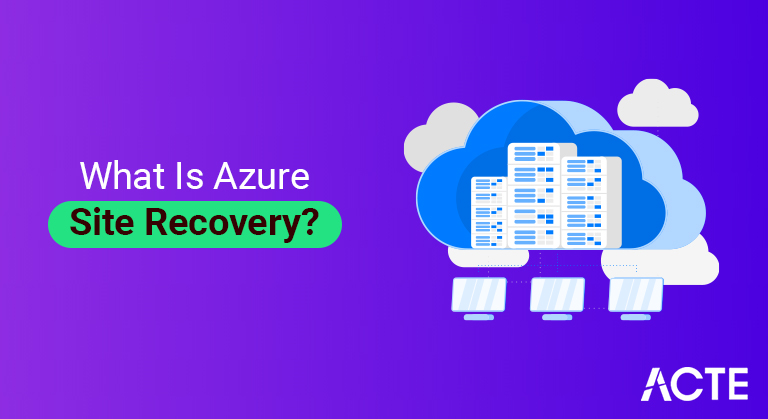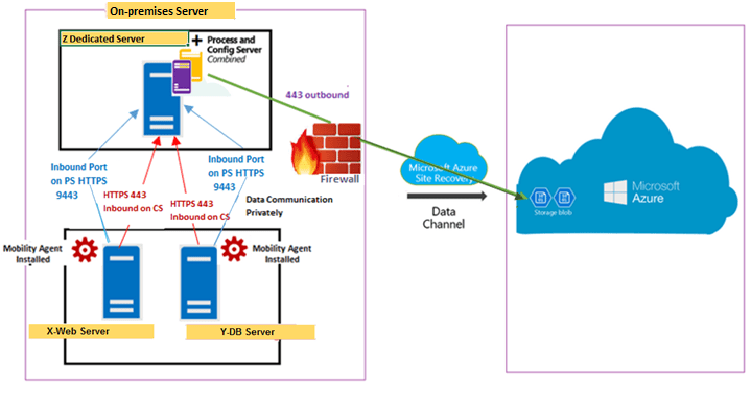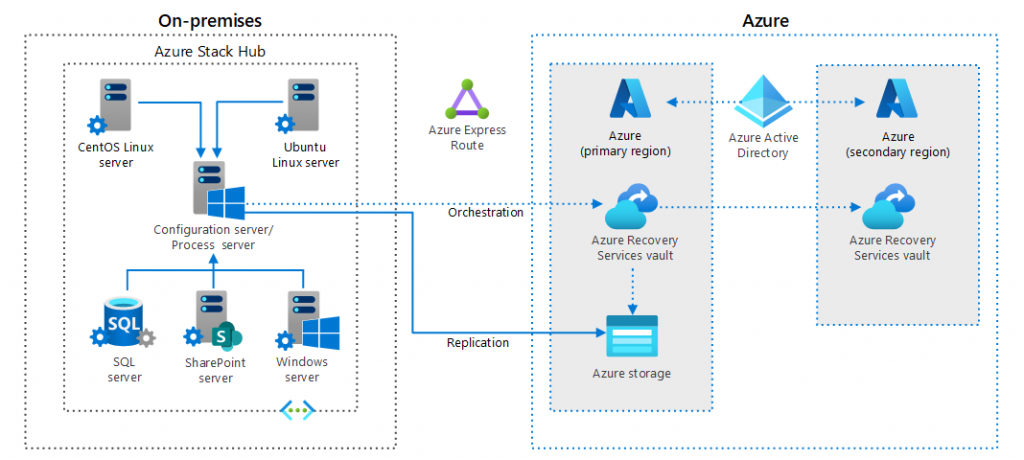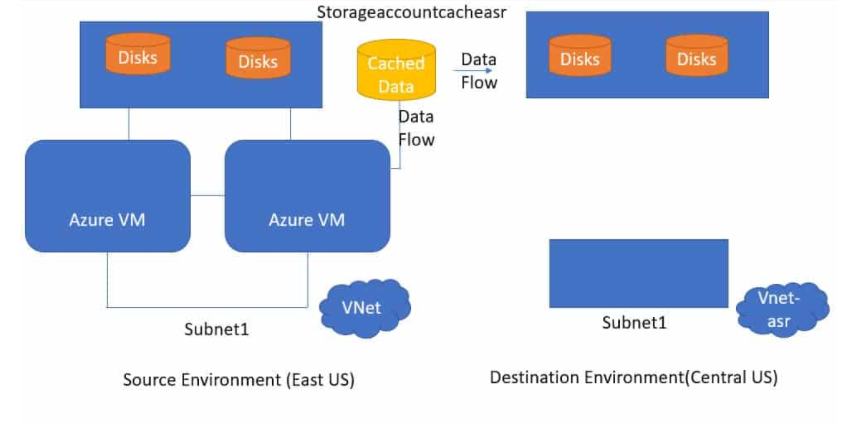
Azure Recovery Services contributes to your BCDR strategy: Site Recovery service: Site Recovery helps ensure business continuity by keeping business apps and workloads running during outages.
- What is ASR in Azure?
- The Advantages of ASR
- Recreate Data to the Cloud With ASR
- Elements of Azure Site Recovery
- Azure Site Recovery Step By Step
- Azure Site Recovery Architecture
- Conclusion
What is ASR in Azure?

Sky blue Site Recovery (ASR) is a DRaaS presented by Azure for use in cloud and half breed cloud structures. A close consistent information replication process ensures duplicates are in a state of harmony. The application steady preview component of Azure Site Recovery guarantees that the information is in usable state after the failover. The assistance empowers clients to involve Azure as a debacle recuperation site on a pay-more only as costs arise model without putting resources into extra framework.
The Advantages of ASR :-
ASR offers cloud-based DRaaS in case of arranged and spontaneous blackouts. We should investigate a portion of the critical advantages of the help.
Cost effective: ASR will charge you for each secured case, notwithstanding the capacity cost for the imitated information. The assistance is free for the initial 31 days, after which the insurance charges will kick in. The information being moved to capacity is compacted with a normal pressure proportion of half, which further lessens the capacity cost. There is no figure, network framework, office rental, or programming permitting expenses needed during continuous assurance.
Data resilience: The reproduced information is put away in Azure stockpiling, which is strong of course. There will be at least three duplicates of the information accessible in locally-excess stockpiling (LRS) to shield from server farm disappointments. For additional security, clients can decide to utilize geo-repetitive capacity (GRS) to shield from local blackouts.
Heterogeneous workload: ASR upholds assurance of Windows and Linux jobs facilitated on actual servers on-premises, VMs facilitated in VMware/Hyper-V, and machines in outsider facilitating stages/cloud. It can likewise shield VMs in Azure from local blackouts. The Azure ASR console gives a brought together view on the replication status of all your various jobs and permits you to do upkeep assignments, for example, tweaking recuperation plans.
Application predictable: ASR catches the in-memory information and exchanges alongside the plate information and guarantees that the recuperation focuses are application-steady. For Windows, it is empowered through VSS and in Linux it is finished utilizing application custom contents.
BCDR reconciliation: ASR gives consistent coordination local application BCDR elements like SQL Always-On and Oracle Data Guard. This makes it feasible for associations to take on the assistance without significant redesigns in their application environment.
Non-troublesome testing: To additionally set up your framework if there should arise an occurrence of a disappointment, ASR can run non-problematic failover and DR drills. This aides in start to finish testing of DR plans without affecting the continuous replication.
RPO and RTO targets: ASR upholds replication frequencies really low customized to meet association explicit RPO and RTO targets. By incorporating computerization runbooks with your recuperation plans just as reconciliation with Traffic director, the RTO can be additionally diminished. Recuperation plans are exceptionally adaptable to permit fast and sequenced failover and recuperation of multi-layered applications such data sets and web administrations.
- There are a few factors that administer a DRaaS procedure: RTO and RPO objectives, stockpiling (IOPS and capacity account), scope quantification, network transfer speed, network reconfiguration, and day by day change rate.
- Purplish blue Site Recovery Deployment Planner can assist you with dissecting your source climate for VMware and Hyper-V conditions and plan for limit and scale in the objective Azure climate.
- One part of Azure ASR to remember now is network arranging. Clients can decide to hold existing IP addresses, yet that would require failover of the whole subnet notwithstanding the machine. On the other hand, another organization range from Azure can be utilized if that works for the application engineering after failover.
- Make a point to survey the help Matrix to comprehend the requirements and Azure Site Recovery constraints while repeating VMs and actual machines to Azure. It is likewise judicious to confirm the sorts of responsibilities that can use application skeptic insurance. You can track down the full rundown here.
- Since we have a strong arrangement dependent on source climate examination and scope organization, we can begin setting up our surroundings for replication. The initial step is to set up the source.
- ASR upholds a few source conditions like VMware, Hyper-V VMs (with or without SCVMM), actual servers, and Azure VMs. It can likewise be utilized for DR of machines in other cloud specialist organizations like AWS or from outsider facilitating administrations utilizing the very cycle that is utilized for securing actual servers. It is essential to take note of that there are various necessities dependent on the source climate.
- For instance, VMware VMs would require extra assets like a setup server, process server, and versatility administrations to help make due, coordinate, and send the scrambled and compacted information pieces to the Recovery Services objective.
- At long last, empower the underlying copy (note: this cycle can take a long while). After the underlying replication is finished, ASR reproduces information in gradual lumps (changed information) at a stretch characterized by your replication strategy.
- Since you have played out the replication, the time has come to approve the arrangement and decide whether and what transforms you really want to make in the event that you need to execute a failover.
- There are three kinds of failovers – test failover, arranged failover, and spontaneous failover. A test failover has no effect on creation, however an arranged or spontaneous failover includes moving the creation site to the replication site like Azure or another host.
- A test Failover should be possible either through a recuperation plan (to arrange failover of different machines) or physically for each VM through the Azure control center.
- Assuming you executed an arranged failover, remember to reprotect the machines after they have flopped over. When your source site is up, you can failback the VMs utilizing the interaction server, ace objective server, and a failback strategy.
- It is prudent to continue to screen your replication settings to guarantee that your RPO targets stay adjusted. You can change replication settings or add scaled out process servers to meet these destinations.
- Aside from giving position cautions on the Azure control center, ASR additionally has its own Event Log Source that can be helpful for investigating replication disappointments. Here is an aide on what occasion sources and ports should be checked out while investigating these disappointments.
Recreate Data to the Cloud With ASR :-

This segment will give a walkthrough to how to recreate information to the cloud utilizing ASR. Similarly as with each DRaaS and movement project, your organization will initially require a spry arrangement to guarantee an effective DRaaS methodology.
1. Planning Stage :
2. Prepare and Configure :
3. Failover and Failback :
4. Make due, Monitor, and Troubleshoot :
Elements of Azure Site Recovery :-
There are numerous astounding highlights given by Azure Site Recovery. How about we examine here a couple of key elements that purplish blue site recuperation gives.
Replication Of Azure VM : Purplish blue Site Recovery gives you the chance to design debacle recuperation for your Azure Virtual Machines starting with one area or locale then onto the next optional area. So that if there should be an occurrence of any debacle or disappointment, you can save your Data.
Replication for Workloads : You can likewise ready to duplicate any of the responsibilities running on your Virtual machines or Physical servers with the goal that it won’t influence your business.
Speedy BCDR Solution : Utilizing Azure Portal, you can rapidly arrange and deal with the failover, replication and afterward you can failback from a solitary spot. On the off chance that you are searching for a fast BCDR Solution, then, at that point, Azure Site Recovery is perhaps the most ideal choice.
Modified Recovery Plans : You can get the chance to modify the recuperation plans dependent on your need like you can set the grouping of failover and recuperation for multi-level applications that are running on various virtual machines, and so on.
- Make a Recovery Services vault.
- Presently, to empower the site Recovery, click on the “+ Enable Site Recovery” button on the Recovery administrations vault page.
- Then, to empower the replication, click on the “Empower replication” under Azure virtual machines as displayed underneath.
- On the Enable replication window – > Source tab, select the beneath choices
- On the Virtual Machines tab, select the virtual machine or every one of the virtual machines that you need to use for the fiasco recuperation, and afterward click on the Next button to move to the replication settings window.
- On the Replication Settings window, audit the replication settings and snap on the Enable replication button.
- Attributable to its expense viability, usability, and backing for a broad rundown of jobs, ASR has laid down a good foundation for itself as a world-forerunner in BCDR arrangements. In any case, for an extra degree of insurance, clients can likewise use NetApp Cloud Volumes ONTAP in Azure to expand BCDR plan for responsibilities facilitated on-premises just as in cross breed cloud conditions.
- As NetApp’s cloud-based variant of the effective ONTAP information the board stage, Cloud Volumes ONTAP offers esteem add through worked away effectiveness, high accessibility, and information replication highlights.
- With SnapMirror® information replication innovation, Cloud Volumes ONTAP can be utilized to repeat information volumes across on-premises and half breed cloud conditions flawlessly and naturally, so information is kept synchronized all of the time.
- SnapMirror additionally permits clients to failover the information to optional destinations during spontaneous blackouts/catastrophes. When the essential site is back up, information can be reproduced back to empower failback. Also the meager provisioning, information pressure, and information deduplication stockpiling efficiencies guarantee your DR information is constantly put away expense proficiently.
- FlexClone innovation assists you with making moment writable clones of volumes with zero stockpiling punishment, making DR testing quicker, more powerful, and more affordable.
- Carrying out the right DRaaS arrangement is non-debatable to guarantee business congruity and shield your jobs from spontaneous possibilities. The right Azure Site Recovery design alongside cutting edge administrations from Cloud Volumes ONTAP can make this excursion simple.
Azure Site Recovery Step By Step :-
All around how about we examine here, How would I set up Azure Site Recovery?. Follow the underneath steps to arrange Azure site recuperation.
Azure Site Recovery Architecture :-
Well, let’s discuss the architecture of the Azure Site Recovery for your Azure Virtual Machines and the different components involved as part of the Azure Site Recovery Architecture.

Conclusion :-





